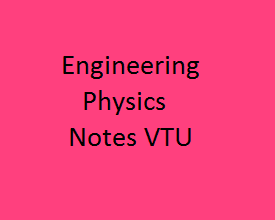Applied Physics Notes Pdf Free Download
Here you can download the free lecture Notes of Engineering Physics Pdf Notes materials with multiple file links to download. The Engineering Physics Notes Pdf book starts with the topics covering Ionic Bond, Covalent Bond, Metallic Bond, Basic Principles, Maxwell-Boltzman, Electron in a periodic Potential, Fermi Level in Intrinsic and Extrinsic Semiconductors, ElectricSusceptibility, Applications of Superconductors, QuantumConfinement, Etc.

Engineering Physics Pdf Notes 1st Year
Note : According to the JNTUH – R13 Syllabus these Engineering Physics Notes 8 units are compressed into 5 units.
Complete Notes
Link: Complete Notes
Unit 1
Link: Unit 1
Unit 2
Link: Unit 2
Unit 3
Link: Unit 3
Unit 4
Link: Unit 4
Unit 5
Link: Unit 5
Unit 6
Link: Unit 6
Unit 7
Link: Unit 7
Unit 8
Link: Unit 8
LIST OF CONTENTS
UNIT-I – Engineering Physics Notes
1. Bonding in Solids: Ionic Bond, Covalent Bond, Metallic Bond, Hydrogen Bond,
Vander-Waal's Bond,
Calculation of Cohesive Energy.
2. Crystallography and Crystal Structures: Space Lattice, Unit Cell, Lattice
Parameters, Crystal Systems,Bravais Lattices, Miller Indices, Crystal Planes and
Directions, Inter Planar Spacing of Orthogonal CrystalSystems, Atomic Radius, Coordination
Number and Packing Factor of SC, BCC, FCC, Diamond and hcp
Structures, Structures of NaCl, ZnS, CsCl.
UNIT-II – Engineering Physics Notes
3. X-ray Diffraction: Basic Principles, Bragg's Law, Laue Method, Powder Method,
Applications of X- ray
Diffraction.
4. Defects in Crystals: Point Defects: Vacancies, Substitutional, Interstitial, Frenkel
and Schottky Defects;Qualitative treatment of line (Edge and Screw Dislocations)
Defects, Burger's Vector, Surface Defects andVolume Defects.
UNIT-III – Engineering Physics Notes
5. Elements of Statistical Mechanics: Maxwell-Boltzman, Bose-Einstein and
Fermi-Dirac Statistics(Qualitative Treatment), Photon gas , Wein's Law, Rayleigh-
Jeans law,, Planck's Law of Black BodyRadiation, Concept of Electron Gas, Fermi
Energy, Density of States.
6. Principles of Quantum Mechanics: Waves and Particles, de Broglie Hypothesis
, Matter Waves,Davisson and Germer's Experiment, G. P. Thomson Experiment,
Heisenberg's Uncertainty Principle,Schrödinger's Time Independent Wave Equation
– Physical Significance of the Wave Function – Particle in
One Dimensional Potential Box.
Engineering physics pdf free download
UNIT-IV – Engineering Physics Notes
7. Band Theory of Solids: Electron in a periodic Potential, Bloch Theorem, Kronig-
Penny Model (Qualitative Treatment), Origin of Energy Band Formation in Solids,
Classification of Materials into Conductors, Semi Conductors & Insulators, Concept
of Effective Mass of an Electron and Hole.
UNIT-V – Engineering Physics Notes
8. Semiconductor Physics: Fermi Level in Intrinsic and Extrinsic Semiconductors,
Intrinsic Semiconductors
and Carrier Concentration, Extrinsic Semiconductors and Carrier Concentration,
Equation of Continuity,Direct & Indirect Band Gap Semiconductors, Hall Effect.
9. Physics of Semiconductor Devices: Formation of PN Junction, Open Circuit PN
Junction, EnergyDiagram of PN Diode, I-V Characteristics of PN Junction, PN Diode
as a Rectifier (Forward and ReverseBias), Diode Equation, LED, LCD and Photo
Diodes.
UNIT-VI – Engineering Physics Notes
10. Dielectric Properties: Electric Dipole, Dipole Moment, Dielectric Constant,
Polarizability, ElectricSusceptibility, Displacement Vector, Electronic, Ionic and
Orientation Polarizations and Calculation ofPolarizabilities – Internal Fields in Solids,
Clausius – Mossotti Equation, Piezo-electricity, Pyro-electricity and
Ferro- electricity.
11. Magnetic Properties: Permeability, Field Intensity, Magnetic Field Induction,
Magnetization, MagneticSusceptibility, Origin of Magnetic Moment, Bohr Magneton,
Classification of Dia, Para and Ferro MagneticMaterials on the basis of Magnetic
Moment, Domain Theory of Ferro Magnetism on the basis of HysteresisCurve, Soft
and Hard Magnetic Materials, Properties of Anti-Ferro and Ferri Magnetic Materials,
Ferrites andtheir Applications, Concept of Perfect Diamagnetism, Meissner Effect,
Magnetic Levitation, Applications of Superconductors.
UNIT-VII` – Engineering Physics Notes
12. Lasers: Characteristics of Lasers, Spontaneous and Stimulated Emission of
Radiation, Meta-stableState, Population Inversion, Lasing Action, Einstein's
Coefficients and Relation between them, Ruby Laser,Helium-Neon Laser, Carbon
Dioxide Laser, Semiconductor Diode Laser, Applications of Lasers.
13. Fiber Optics: Principle of Optical Fiber, Acceptance Angle and Acceptance
Cone, Numerical Aperture,Types of Optical Fibers and Refractive Index Profiles,
Attenuation in Optical Fibers, Application of OpticalFibers.
UNIT-VIII – Engineering physics lecture notes
14. Acoustics of Buildings & Acoustic Quieting: Basic Requirement of
Acoustically Good Hall,Reverberation and Time of Reverberation, Sabine's Formula
for Reverberation Time(Qualitative Treatment),Measurement of Absorption
Coefficient of a Material, Factors Affecting The Architectural Acoustics and
theirRemedies. Acoustic Quieting: Aspects of Acoustic Quieting, Methods of
Quieting, Quieting for SpecificObservers, Mufflers, Sound-proofing.
15. Nanotechnology: Origin of Nanotechnology, Nano Scale, Surface to Volume
Ratio, QuantumConfinement, Bottom-up Fabrication: Sol-gel, Precipitation,
Combustion Methods; Top-down Fabrication:Chemical Vapour Deposition, Physical
Vapour Deposition, Pulsed Laser Vapour Deposition Methods
Engineering Physics Imp Questions :-Click Here for Imp Qusts
Follow us on FB – Smartzworld
Frequently Asked Question
Q1: What is Bonding and what are its types?
A1: Physical state of existing in a bound form of two or more atoms together is called Bonding. Dissociation is the external energy required to get back the bonded atoms to free state as energy is needed to break the bonds. Type of bonding in solids are,
- Primary bonds which include iconic, covalent and metallic bonding
- Secondary bonds which have Vander waal's and hydrogen bonds.
Source: https://www.smartzworld.com/notes/engineering-physics-pdf-notes-1st-year/
Posted by: donalddonaldsircye0272233.blogspot.com
Post a Comment for "Applied Physics Notes Pdf Free Download"